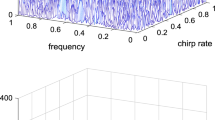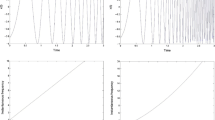Abstract
In this paper, a parameter estimation method for multi-component chirp signals with white Gaussian noise is proposed based on the modified discrete chirp Fourier transform (MDCFT) and the population Monte Carlo (PMC) methodology, in which the model order is unknown. By utilizing the integrability of linear parameters in the Bayesian model, this paper considers the posterior distribution of nonlinear parameters. MDCFT was adopted to calculate the chirpogram of the observed data, and clear peaks can be detected in the discrete chirp Fourier transform domain. The importance function (IF) was constructed according to the peaks, and the PMC algorithm was employed to evaluate the posterior distribution. The proposed method cannot only use the selected IF to generate the sample fitting target function in the parameter region of interest, but can also utilize samples and importance weights to update the IF adaptively. The simulation results indicated that the proposed method can realize joint Bayesian model selection and parameter estimation of multi-component chirp signals. Compared with the two existing methods based on Monte Carlo methodology, the proposed method exhibits improved performance.







Similar content being viewed by others

References
Djuric, P.M., Kay, S.M.: Parameter estimation of chirp signals. IEEE Trans. Acoust. Speech Signal Process. 38(12), 2118–2126 (1999)
Li, H.S., Djuric, P.M.: MMSE estimation of nonlinear parameters of multiple linear & quadratic chirps. IEEE Trans. Signal Process. 46(3), 796–800 (1998)
Abatzoglou, T.J.: Fast maximum likelihood joint estimation of frequency and frequency rate. In: IEEE International Conferenceon Aerospace Electronic Systems, Tokyo, Japan, April 7–11 (1986)
Besson, O., Ghogho, M., Swami, A.: Parameter estimation for random amplitude chirp signals. IEEE Trans. Signal Process. 47(12), 208–3219 (1999)
Ikram, M.Z., Meraim-Abed, K., Hua, Y.: Iterative parameter estimation of multiple chirp signals. Electron. Lett. 33(8), 657–659 (1997)
Ikram, M.Z., Meraim-Abed, K., Hua, Y.: Estimating the parameters of chirp signals: an iterative approach. IEEE Trans. Signal Process. 46(12), 3436–3441 (1998)
Barbarossa, S.: Analysis of multicomponent LFM signals by a combined Wigner–Hough transform. IEEE Trans. Signal Process. 43(6), 1511–1515 (1995)
Guo, J., Zou, H., Yang, X., Liu, G.: Parameter estimation of multicomponent chirp signals via sparse representation. IEEE Trans. Aerosp. Electron. Syst. 47(3), 2261–2268 (2011)
Applebaum, L., Howard, S.D., Searle, S., Calderbank, R.: Chirp sensing codes: deterministic compressed sensing measurements for fast recovery. Appl. Comput. Harmon. Anal. 26(2), 283–290 (2009)
Millioz, F., Davies, M.: Sparse detection in the chirplet transform: application to FMCW radar signals. IEEE Trans. Signal Process. 60(6), 2800–2813 (2012)
Mallat, S.G., Zhang, Z.: Matching pursuits with time-frequency dictionaries. IEEE Trans. Signal Process. 41(12), 3397–3415 (1993)
Andrieu, C., Doucet, A.: Joint Bayesian model selection and estimation of noisy sinusoids via reversible jump MCMC. IEEE Trans. Signal Process. 47(10), 2667–2676 (1999)
Davy, M., Doncarli, C., Tourneret, J.Y.: Classification of chirp signals using hierarchical Bayesian learning and MCMC methods. IEEE Trans. Signal Process. 50(2), 377–388 (2002)
Lin, C.C., Djuric, P.M.: Estimation of chirp signals by MCMC. in: ICASSP ’00. Proceedings, June 5–9, pp. 265–268 (2000)
Lin, Y., Peng, Y., Wang, X.: Maximum likelihood parameter estimation of multiple chirp signals by a new Markov Chain Monte Carlo approach. In: IEEE Radar Conference Proceedings, Philadelphia, USA, Apr. 26–29, pp. 559–562 (2004)
Saha, S., Kay, S.M.: Maximum likelihood parameter estimation of superimposed chirps using Monte Carlo importance sampling. IEEE Trans. Signal Process. 50(2), 224–230 (2002)
Cappe, O., Guillin, A., Marin, J.M., Robert, C.P.: Population Monte Carlo. J. Comput. Graph. Stat. 13(4), 907–929 (2004)
Hong, M., Bugallo, M.F., Djuric, P.M.: Joint model selection and parameter estimation by population Monte Carlo simulation. IEEE J. Sel. Top. Signal. Process. 4(3), 526–539 (2010)
Bugallo, M.F., Hong, M., Djuric, P.M.: Marginalized population Monte Carlo. In: ICASSP ’09. Proceedings, Taipei, Taiwan, April 19–24, pp. 2925–2928 (2009)
Shen, B., Bugallo, M.F., Djuric, P.M.: Estimation of multimodal posterior distributions of chirp parameters with population Monte Carlo sampling. In: ICASSP ’12. Proceedings, Kyoto, Japan, March 25–30, pp. 3861–3864 (2012)
Xia, X.G.: Discrete chirp-Fourier transform and its application to chirp rate estimation. IEEE Trans. Signal Process. 48(11), 3122–3133 (2000)
Fan, P., Xia, X.G.: Two modified discrete chirp-Fourier transform schemes. Sci. China, Ser. F 44(5), 329–341 (2001)
Guo, X., Sun, H.B., Wang, S.L.: Comments on discrete chirp-Fourier transform and its application to chirp rate estimation. IEEE Trans. Signal Process. 50(12), 3115–3116 (2002)
Xia, X.G.: Response to comments on discrete chirp-Fourier transform and its application to chirp rate estimation. IEEE Trans. Signal Process. 50(12), 3116 (2002)
Wu, L., Wei, X.Z., Yang, D.G., Wang, H.Q., Li, X.: ISAR imaging of targets With complex motion based on discrete chirp Fourier transform for cubic chirps. IEEE Trans. Geosci. Remote Sens. 50(10), 4201–4212 (2012)
Darren, W., Martin, K., Karim, B., Olivier, C., Jean, F.C., Gersende, F., Simon, P., Christian, P.R.: Estimation of cosmological parameters using adaptive importance sampling. Phys. Rev. D 80(2), 1511–1539 (2009)
Cheng, H., Zeng, D., Zhu, J., Tang, B.: Maximum likelihood estimation of co-channel multicomponent polynomial phase signals using importance sampling. Progress Electromagn. C 23, 111–122 (2011)
Kilbinger, M., Wraith, D., Robert, C.P., Benabed, K., Cappé, O., Cardoso, J.F., Fort, G., Prunet, S., Bouchet, F.R.: Bayesian model comparison in cosmology with population Monte Carlo. MNRAS 405(4), 2381–2390 (2010)
Douc, R., Guillin, A., Marin, J.M., Robert, C.P.: Convergence of adaptive mixtures of importance sampling schemes. Ann. Appl. Stat. 35(1), 420–448 (2007)
Friedlander, B., Francos, J.M.: Estimation of amplitude and phase parameter of multicomponent signals. IEEE Trans. Signal Process. 43(4), 917–926 (1995)
Acknowledgments
The authors would like to thank the anonymous reviewers for their valuable comments that helped improve this paper to its present form.
Author information
Authors and Affiliations
Corresponding author
Appendices
Appendix 1
The posterior distribution of \(\left( {\varvec{\alpha }, {\varvec{f}},{\varvec{s}},\sigma _\varepsilon ^2 ,K} \right) \) can be expressed as follows according to the likelihood function of \({\varvec{y}}\) given in Eq. (3) and the a priori of each parameter given in Eqs. (6) and (7):
Referring to the literature [12, 13, 18], the expression after integrating terms relevant to amplitudes \(\varvec{\alpha }\) in Eq. (25) is given as
where
Equation (26) has a Gaussian function of \(\varvec{\alpha }\) and inverse Gamma function of \(\sigma _\varepsilon ^2 \). After the integration of these two variables in (26), the posterior distribution of the observed data \({\varvec{y}}\) on \(K, {\varvec{f}}\), and \({\varvec{s}}\) is
Appendix 2
We assume that \(p\left( \varvec{\theta } \right) \) is the target function; \(q^{\left( t \right) }\left( \varvec{\theta } \right) \) represents the IF in the \(t\)th iteration; and \(\varvec{\theta }\) represents the unknown parameters. When applying the PMC methodology to the parameter estimation problem, whether the adopted IF can be approximated to the target function is important. Our objective is to minimize the Kullback divergence, which can be expressed as \(K\left( {p|| q^{\left( t \right) }} \right) =\int {\log \left( {\frac{p\left( \varvec{\theta } \right) }{q^{\left( t \right) }\left( \varvec{\theta } \right) }} \right) p\left( \varvec{\theta } \right) \mathrm{d}\varvec{\theta }}\).
Assume \(h_d \left( {\varvec{\theta };\alpha ,\varvec{\xi }} \right) =\frac{\alpha _d g\left( {\varvec{\theta };\varvec{\xi }_d } \right) }{\sum \nolimits _{d=1}^D {\alpha _d g\left( {\varvec{\theta };\varvec{\xi }_d } \right) } }\). In \(t\)th iteration, the intermediate quantity is constructed as
The derivation in [26, 28, 29] indicates that for any \(\alpha \) and \(\varvec{\xi }\), when the intermediate quantity (31) increases, the target function also increases. The maximum \(L^{\left( t \right) }\left( {\alpha ,\varvec{\xi }} \right) \) canobtain a closed solution. In the multivariate Gaussian distribution, the parameters include mean value and covariance matrix. The intermediate quantity can be expressed as
up to terms that do not depend on \(\alpha ,\varvec{\xi }\).
When the above formula reaches the minimum, the following equations are satisfied:
In practice, the numerator and the denominator are integral. By utilizing the samples and weights in each iteration for approximation, Eqs. (19)–(21) can be obtained.
Rights and permissions
About this article
Cite this article
Yang, P., Liu, Z. & Jiang, WL. Parameter estimation of multi-component chirp signals based on discrete chirp Fourier transform and population Monte Carlo. SIViP 9, 1137–1149 (2015). https://doi.org/10.1007/s11760-013-0552-0
Received:
Revised:
Accepted:
Published:
Issue Date:
DOI: https://doi.org/10.1007/s11760-013-0552-0



